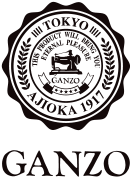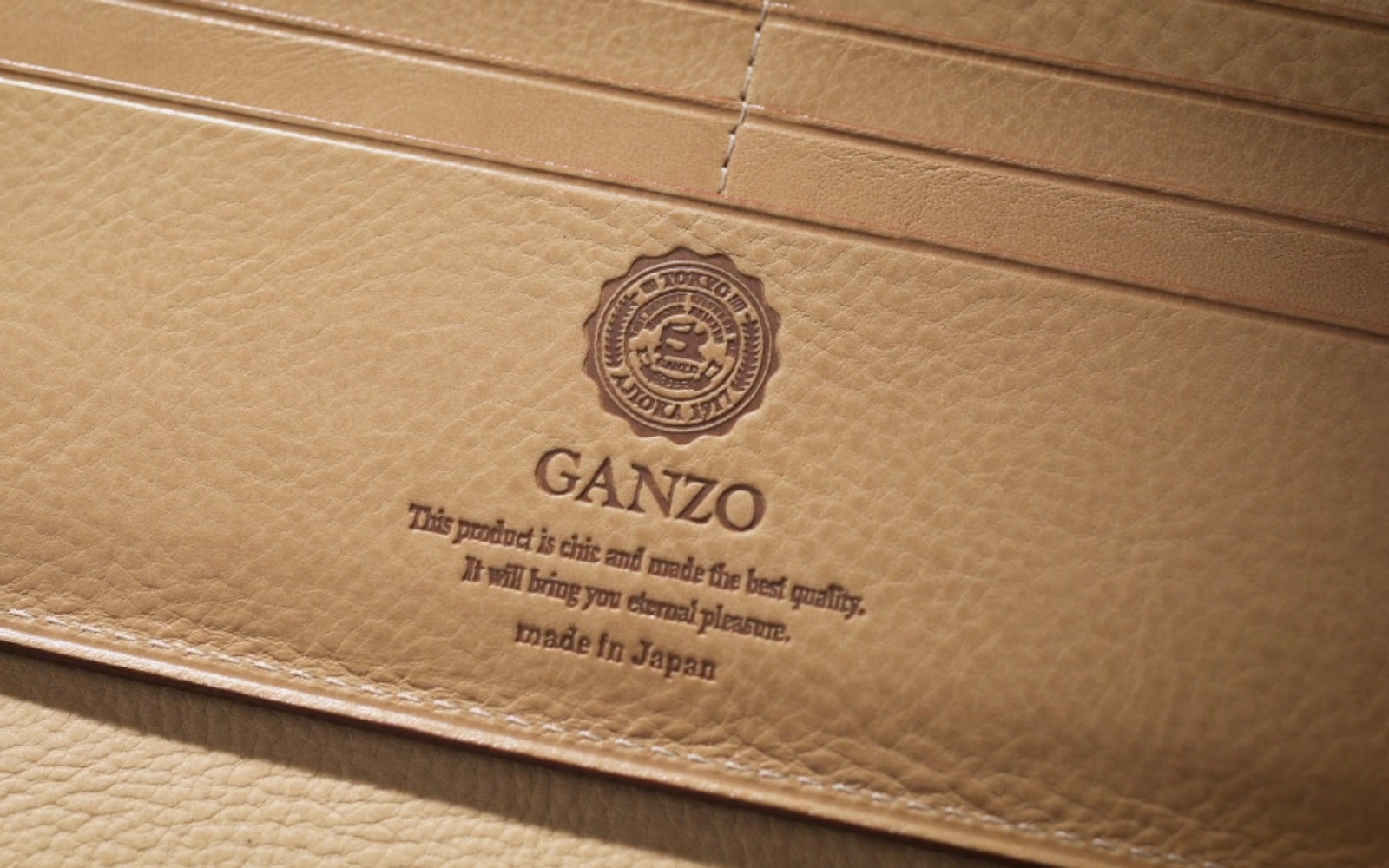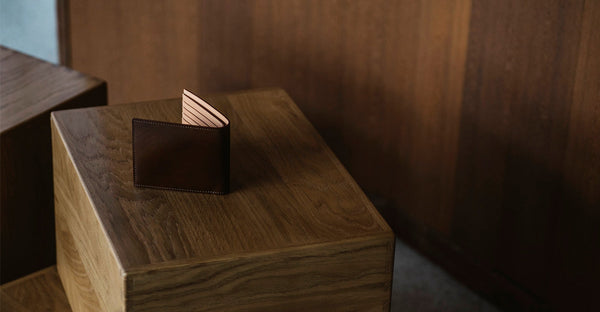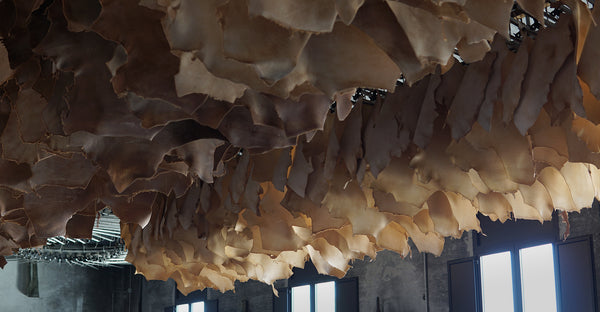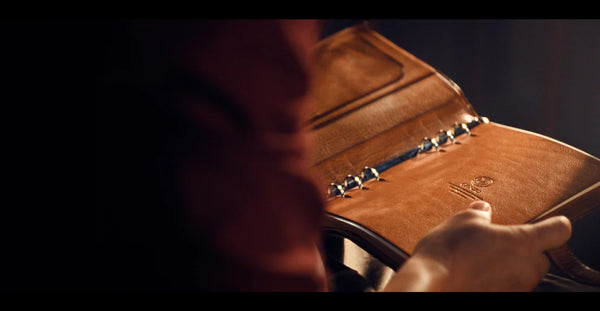GANZO’S METHOD
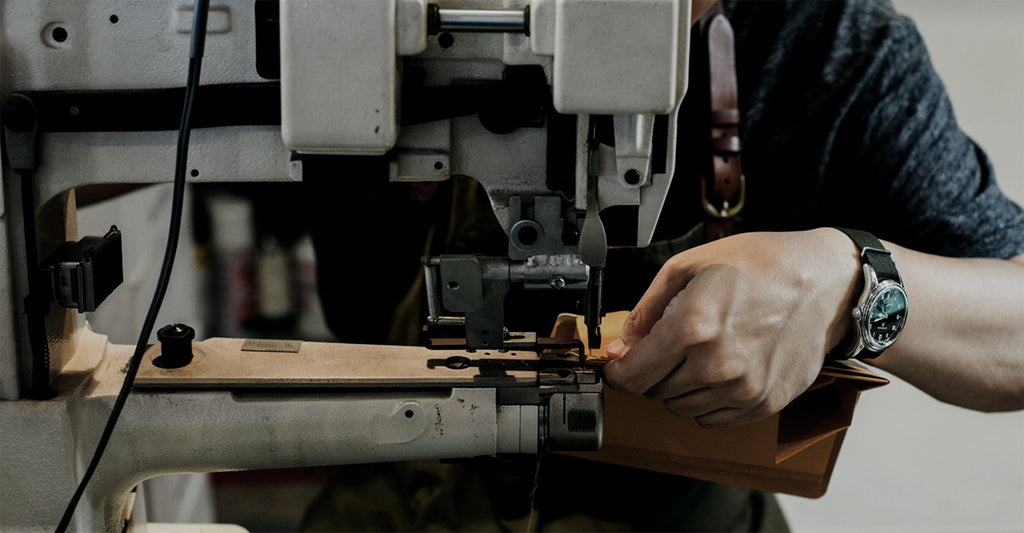

GANZO'S METHOD

GANZO’s Leather Products
The greatest of leather products change with time. As they age, they take on the character of their owner, becoming richer and deeper as days go by.
GANZO takes pride in its leather, carefully constructing its products for maximal expression of the leather’s texture.
For example, one high-grade part development process is called ”creasing” or leather-cutting. Large pieces of leather aren’t uniform everywhere; different parts have different roughness and texture. At GANZO, we record the locations and orientation of such textural features so that, after the leather is cut, these patterns match up in our final product.
Without such care and love, the leather will not keep its texture after long use by our customers.
Now take a look below at each step of GANZO’s imaginative and creative leatherworking process. This is the secret of our quality.
What It Takes to Make a GANZO Product

| Cutting | Blackening (Edges) | Creasing |
|---|---|---|
| Each part is cut out using a pattern paper guide. We cut every piece individually - even the tiniest differences in cutting can ruin the beauty of the finished product. | The edges of the leather are colored to bring out the feel of the entire piece. Coating is applied twice using a proprietary Bordeaux color dye. Although this process appears simple, it is actually quite a difficult procedure. | A process called “creasing” is done around the edges of each piece. A heated iron is used to apply finely detailed lines to the leather. This purely ornamental procedure it gives rise to beautiful accents on the leather. |
| Assembly and Sewing | Bagged Edge | Burnishing |
| Once all of the parts have their edges polished and creased, they are assembled in the sewing process. Every aspect, from the location of individual stitches to their angle, are subject to GANZO’s strict proprietary methods. | The edges of the leather are lined with glue and folded inward in a process called "turning". This process increases the strength of individual part. Delicate care is taken to avoid warping or bending of the material. | A cotton cloth is used to spread varnish on the leather edges in a process called "burnishing". Soon after polishing begins, the edges quickly develop a brilliant shine. The same process also has a beveling effect, vastly improving the feel of the leather. |
| Cutting |
|---|
| Each part is cut out using a pattern paper guide. We cut every piece individually - even the tiniest differences in cutting can ruin the beauty of the finished product. |
| Blackening (Edges) |
| The edges of the leather are colored to bring out the feel of the entire piece. Coating is applied twice using a proprietary Bordeaux color dye. Although this process appears simple, it is actually quite a difficult procedure. |
| Creasing |
| A process called “creasing” is done around the edges of each piece. A heated iron is used to apply finely detailed lines to the leather. This purely ornamental procedure it gives rise to beautiful accents on the leather. |
| Assembly and Sewing |
| Once all of the parts have their edges polished and creased, they are assembled in the sewing process. Every aspect, from the location of individual stitches to their angle, are subject to GANZO’s strict proprietary methods. |
| Bagged Edge |
| The edges of the leather are lined with glue and folded inward in a process called "turning". This process increases the strength of individual part. Delicate care is taken to avoid warping or bending of the material. |
| Burnishing |
| A cotton cloth is used to spread varnish on the leather edges in a process called "burnishing". Soon after polishing begins, the edges quickly develop a brilliant shine. The same process also has a beveling effect, vastly improving the feel of the leather. |
Inside GANZO Leather Products (Thin Bridle Series)

GANZO’s Bridle Leather
(J&E Sedgwick & Co. Ltd)
GANZO’s Bridle Leather Series uses bridle leather from UK company J&E Sedgwick & Co. Ltd.
Since its establishment more than a century ago, J&E Sedgwick has provided quality leather to the harnessing industry. A century later, they are still the world leader in harness leather. In order to ensure the safety of the rider, J&E Sedgwick’s leather is made with a penchant for durability and strength. The leather has continually cleared the strict regulatory inspections of the UK Leather Federation.
To prevent the leather from cracking, the leather is repeatedly treated with natural tallow and waxes. This is the source of bridle leather’s characteristic white, powdery-looking patches, called a bloom.
Structure: Thin Bridle Wallet with Fastener
The Thin Bridle Wallet With Fastener is made up of nearly 40 individual parts.
This product’s complicated construction requires detailed measurements of each of the parts and careful construction for each stage starting from cutting.
Have a look at the careful construction GANZO’s individual parts below.
-


The card pockets are made up of two general parts - the hidden lining in the back and the visible portion in the front.
These are constructed from long, thinly-cut strips of leather.
After construction, the individual leather pieces disappear,forming a unified, solid structure. -


The characteristic of GANZO wallets is their perfect curvature that neither expands too much nor folds too far.
The careful artisan’s craft and measurement comes to light. -


These card holders have the same construction as those above.
Each holder is made from the center by piecing together individual parts by one final sewing from the outside, producing a uniform structure.
It looks quite simple, but the process is complicated. -


The surface bridle leather is made as thin as possible to bring out the maximum suppleness and flexibility.
To prevent stiffening and warping, the back surface of the bridle leather has a special core material applied made of leather composites. -


This pocket is for holding coins.
Most wallets from other companies use fabric, but at GANZO we use real cowhide(may vary by series).
This is because only real leather can be treated by burnishing. -


The gusset portion of the wallet has a “sasamachi” structure.
Sasa means bamboo in Japanese.
This name comes from the V-shaped, bamboo-like appearance of the wallet when looked at from the side.
This shape allows the wallet to folds extraordinarily well.
This structure also allows freedom for storage, letting you use the wallet how you like. -


The back surface of the card holders take careful consideration of durability and feel, using cowhide dyed in an original, proprietary color.
Even in invisible places, you can catch a feel of of GANZO’s penchant for quality.
- Card Holders
- Fold
- Card Holders
-


These card holders have the same construction as those above.Each holder is made from the center by piecing together individual parts by one final sewing from the outside, producing a uniform structure.It looks quite simple, but the process is complicated.
- Surface Leather and Core
-


The surface bridle leather is made as thin as possible to bring out the maximum suppleness and flexibility. To prevent stiffening and warping, the back surface of the bridle leather has a special core material applied made of leather composites.
- Coin Pocket
-


This pocket is for holding coins. Most wallets from other companies use fabric, but at GANZO we use real cowhide (may vary by series). This is because only real leather can be treated by burnishing.
- Gusset
-


The gusset portion of the wallet has a “sasamachi” structure. Sasa means bamboo in Japanese. This name comes from the V-shaped, bamboo-like appearance of the wallet when looked at from the side. This shape allows the wallet to folds extraordinarily well. This structure also allows freedom for storage, letting you use the wallet how you like.
- Card Holder Back Surface
-


The back surface of the card holders take careful consideration of durability and feel, using cowhide dyed in an original, proprietary color. Even in invisible places, you can catch a feel of of GANZO’s penchant for quality.
